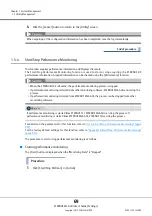
Chapter 1 System Management
1.4 System Management
ETERNUS Web GUI User’s Guide (Settings)
Copyright 2015 FUJITSU LIMITED
P2X0-1270-13ENZ0
54
■
When Setting the EXCP
RAID groups that are used as EXCPs are configured with RAID0 including at least one drive.
Requirements for selecting drives
•
The drive requirements for creating RAID groups are listed below.
-
The drive status is "
Present"
-
The drives are not registered in any RAID group, TPP, FTRP, REC Disk Buffer, or EXCP
-
The drives are not registered as hot spares
-
When using the ETERNUS DX8700 S3/DX8900 S3, the drives that are installed in the DE that is
connected to the CE with the CM where the EXCP memory size is to be set must be selected
•
Drive recommendations for creating RAID groups are listed below.
-
Select drives with the same capacity. If drives of different capacities exist in a RAID group, the smallest
capacity becomes the standard, and all other drives are regarded as having the same capacity as the
smallest drive. In this case, the remaining drive space is not used.
-
Select SSDs with the same type (SSD-M/SSD). If different types of SSDs exist in a RAID group, the access
performance for all SSDs in the RAID group is adjusted to the SSD of the lowest interface speed.
Procedure
1
Click [Setup Extreme Cache] in [Action].
2
Select "Extreme Cache Pool" for "Cache Used".
■
For the ETERNUS DX8700 S3/DX8900 S3
•
EXCP does not work when operating in an environment with a high cache hit rate.
•
It is recommended that "Extreme Cache" is used instead of "Extreme Cache Pool" for the ETERNUS DX500
S3/DX600 S3 and the ETERNUS DX8700 S3/DX8900 S3. "Extreme Cache" operates faster than "Extreme
Cache Pool".
Содержание Eternus DX200F
Страница 2: ...This page is intentionally left blank ...
Страница 1082: ......






























